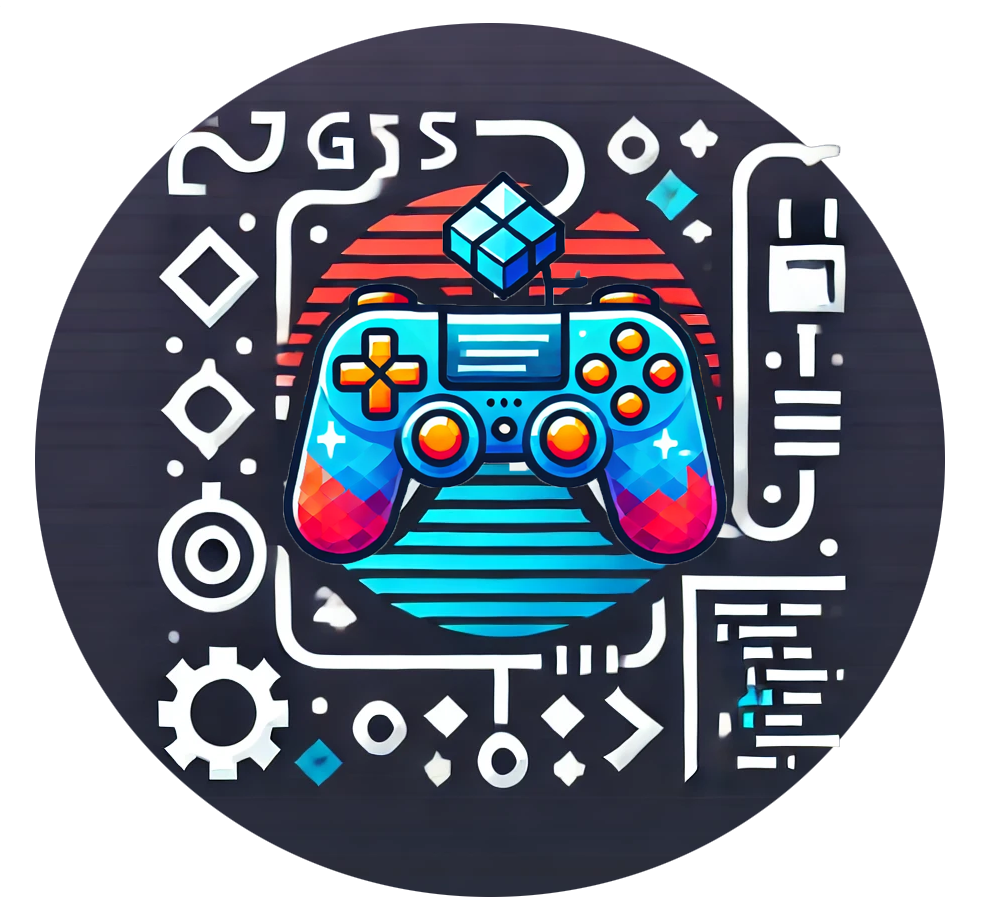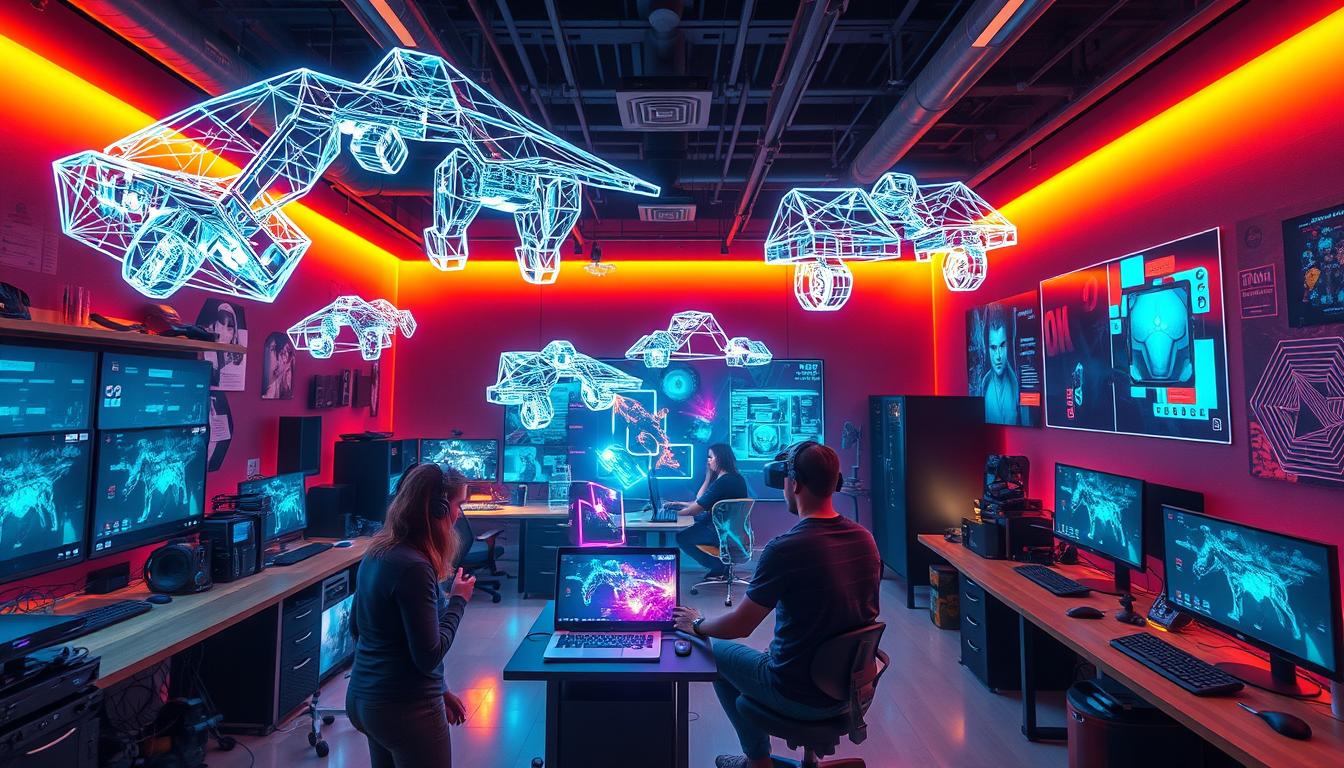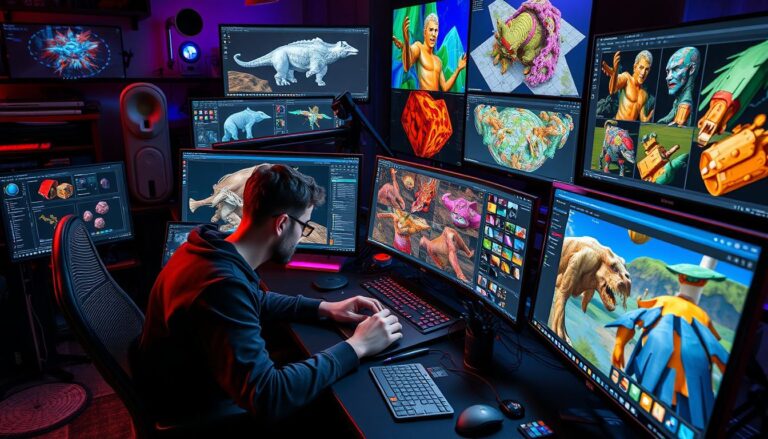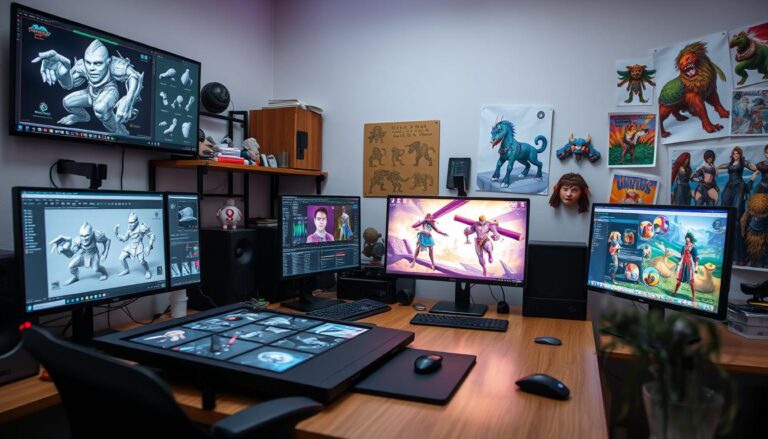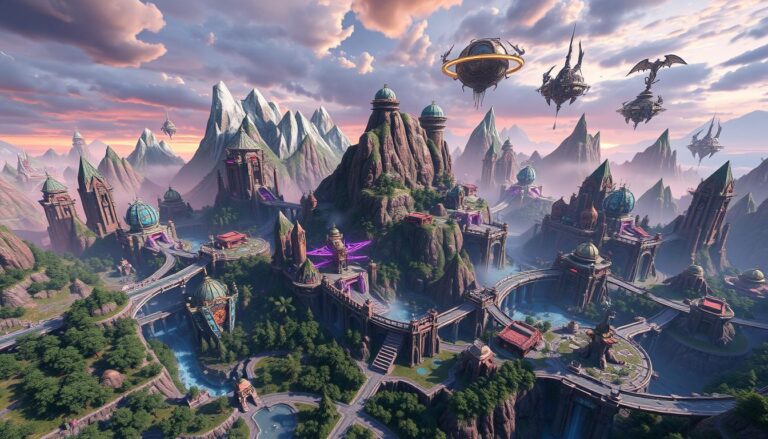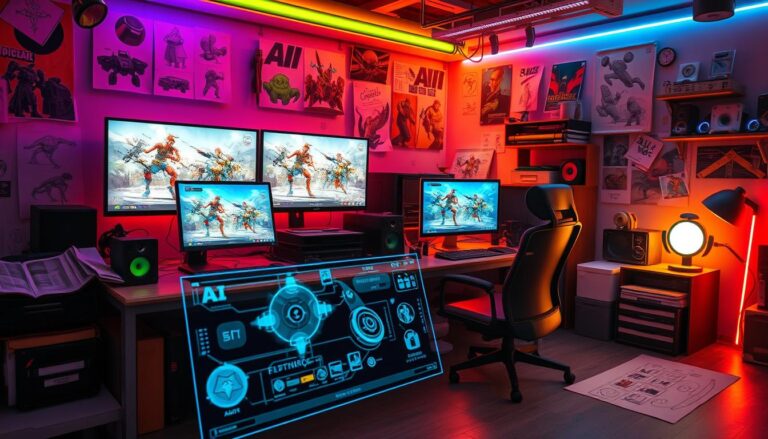How Can You Use VR and AR in 3D Games?
The gaming world is changing fast with virtual reality (VR) and augmented reality (AR). In 2022, AR games made $8.4 billion, and this number is set to hit $43.1 billion by 2028. VR games made $12.13 billion in 2022 and are expected to reach $2.4 billion by 2024. These technologies are making games more interactive and fun.
VR and AR are key in 3D game development now. They let users dive into virtual worlds, mixing digital and real life. Game makers use these tools to create experiences that grab players’ attention like never before.
Understanding VR and AR Technologies in Gaming
The gaming world is changing fast, thanks to Virtual Reality (VR) and Augmented Reality (AR). These new technologies are making games more real and fun. They mix the virtual and real worlds in exciting ways.
Virtual Reality Gaming Fundamentals
Virtual Reality takes you into a world that feels real. It uses game engines, 3D modeling, and texturing to make games feel like life. With a VR headset and controllers, you can move around and touch virtual things.
Augmented Reality Gaming Basics
Augmented Reality adds cool digital stuff to the real world. It lets you see games and fun things mixed with your surroundings. You can use phones, tablets, or AR glasses to see this magic.
Key Differences Between VR and AR Gaming
VR and AR are both cool, but they work in different ways. VR takes you into a complete virtual world. AR adds digital stuff to the real world. VR needs special gear, while AR works with things you already have.
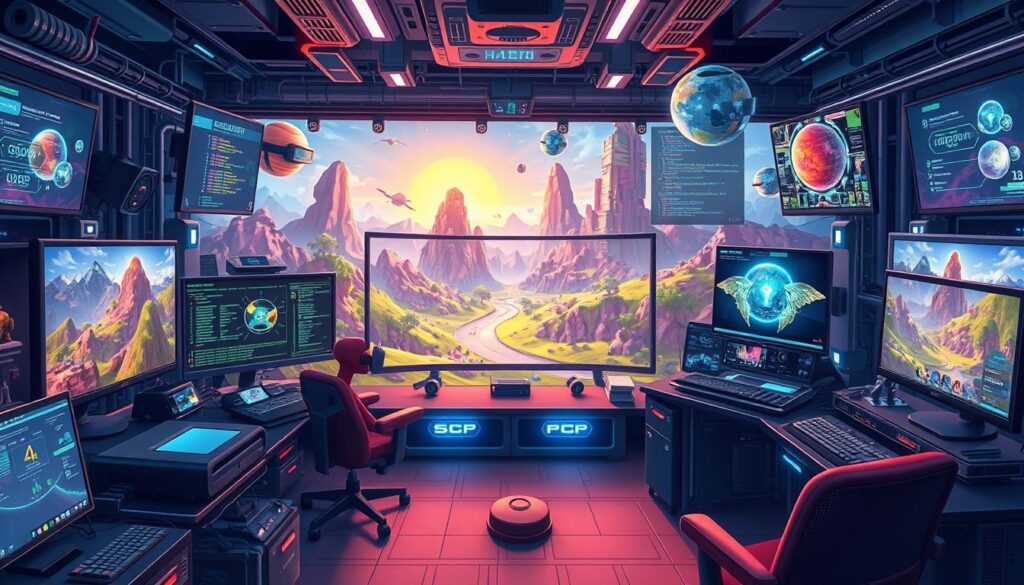
| Virtual Reality Gaming | Augmented Reality Gaming |
|---|---|
| Fully Immersive 3D Environment | Blends Virtual Elements with Reality |
| Requires Dedicated Headsets and Controllers | Can Be Experienced Through Smartphones, Tablets, or AR Glasses |
| Utilizes Advanced Game Engines, 3D Modeling, and Texturing | Overlays Digital Information on the Physical World |
| Provides a Fully Immersive, Self-Contained Virtual Experience | Enhances the Existing Physical Environment with Digital Elements |
Market Growth and Impact on Gaming Industry
The market for augmented reality (AR) and virtual reality (VR) in gaming is expected to hit $11.0 billion by 2026. It will grow at a rate of 18.5% each year from 2021 to 2026. This rapid growth comes from AR and VR becoming more common in mobile phones and wearables. This makes these experiences available to more people.
Experts predict a huge increase in AR and VR headset sales. By 2023, over 26 million units will be sold each year. This demand is driving more investment in animation and level design. Game developers are working hard to make games more immersive and fun for players.
| Region | Market Size (USD Billion) | CAGR (%) |
|---|---|---|
| North America | 4.5 | 16.8 |
| Europe | 2.9 | 17.5 |
| Asia-Pacific | 3.1 | 20.1 |
| Rest of the World | 0.5 | 16.3 |
The focus on Animation and Level Design shows how important immersive gaming is becoming. As AR and VR get better and more people can use them, the gaming world will change. These technologies will play a big role in shaping the future of gaming.
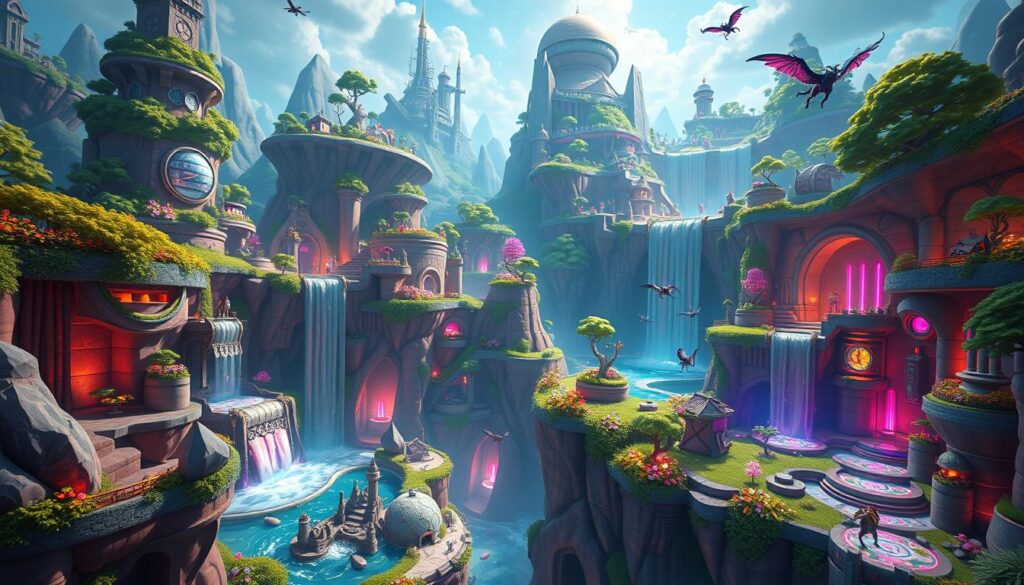
3D Game Development with VR and AR Integration
Creating immersive 3D games with VR and AR needs special tools and strategies. The right development platforms, performance optimization, and blending Scripting, Game Physics, and Shaders are key. This ensures engaging VR and AR gaming experiences.
Essential Development Tools and Platforms
Unity and Unreal Engine lead in VR and AR game development. They support creating virtual environments, handling Scripting and Game Physics, and using Shaders for stunning graphics. AR platforms like ARKit and ARCore also help in AR game development.
Implementation Strategies
- Crafting Immersive Environments: VR and AR let developers create virtual worlds that feel real.
- Realistic Physics Simulation: Accurate Game Physics makes virtual objects act naturally, improving the experience.
- Interactive Elements: Advanced Scripting and Shaders add interactivity to virtual objects and environments.
Technical Requirements and Considerations
VR and AR game development faces technical challenges. These must be solved for the best performance and user comfort. Key areas include:
- Performance Optimization: Smooth frame rates and low latency are crucial. This is achieved by managing Scripting, Game Physics, and Shaders.
- Motion Sickness Mitigation: Techniques like adjusting camera movements help reduce motion sickness.
- Seamless AR Integration: Virtual objects must blend smoothly into the real world. This is done using AR platforms and Shaders.
| Statistic | Value |
|---|---|
| 50%+ of week one Must Play Apple Arcade Games for Vision Pro were made with Unity | 50%+ |
| 2/3 of the most popular Quest experiences were made with Unity | 2/3 |
| 70%+ of top-selling Quest games are made with Unity | 70%+ |
Popular Types of VR and AR Games
The gaming world is changing fast, thanks to Virtual Reality (VR) and Augmented Reality (AR). These new technologies let players dive into digital worlds like never before. They mix the real and virtual in exciting ways.
VR games are getting more popular, with genres like first-person shooters and action-adventure leading the way. Games like Beat Saber show how VR can make gaming fun and immersive. They use Real-Time Rendering and 3D Modeling to create real-like virtual worlds.
AR games, on the other hand, focus on location-based experiences and puzzles. Pokemon GO and Ingress Prime are great examples. They mix digital and real-world elements, making games feel more interactive and fun.
| VR Game Types | AR Game Types |
|---|---|
|
|
The gaming world is excited about VR and AR. These technologies open up endless possibilities for new games. With Real-Time Rendering and 3D Modeling, developers can make worlds that feel real and engaging.
Challenges and Solutions in VR/AR Game Creation
Creating VR and AR games is tough. Developers face many challenges, like hardware limits, making games feel right, and keeping them running smoothly.
Hardware Limitations and Solutions
VR and AR games need more power than regular games. They must show real-looking scenes fast and keep the game running smoothly. This is hard. Developers must work on Game Physics, Shaders, and Real-Time Rendering to make the game feel real.
To get around hardware problems, developers make games for many VR and AR systems. They use special tools and libraries for each system. This helps them use the system’s best features.
User Experience Optimization
It’s important to make VR and AR games easy to use and fun. Some people get sick from using VR or AR. To help, developers can add settings to make the game more comfortable. They can also make the game feel more real by adding visual cues.
Developers also need to make controls easy to use. They might try new ways to control the game, like hand gestures or voice commands. This makes the game feel more real and fun.
Performance Optimization Techniques
VR and AR games need to run well to be fun. If the game slows down, it can ruin the experience. Developers use tricks like showing less detail in the distance and making the game’s physics work fast. They also make sure the game looks good on different computers.
By solving these problems, developers can make VR and AR games that are fun and exciting. These games can make players feel like they’re really there.
| Challenge | Solution |
|---|---|
| Hardware Limitations | Optimize Game Physics, Shaders, and Real-Time Rendering; Target multiple VR and AR platforms with platform-specific SDKs and libraries |
| User Experience Optimization | Implement comfort settings, adjust camera movements, incorporate visual cues to reduce motion sickness; Explore intuitive controls and interactions |
| Performance Optimization | Leverage level-of-detail rendering, efficient Game Physics calculations, and optimized Shaders |
Conclusion
3D game development has changed the gaming world with virtual reality (VR) and augmented reality (AR). These technologies offer players deep immersion and engagement. As VR and AR games grow in popularity, developers use advanced tools to tackle challenges.
The future of 3D gaming looks bright with advancements in artificial intelligence (AI) and 5G. These will expand what’s possible in VR and AR. Developers will keep finding new ways to make games more interactive, visually stunning, and personal.
The progress in 3D game development and VR/AR is exciting for gamers and industry experts. The industry’s ongoing innovation means endless possibilities for immersive and groundbreaking 3D games.
